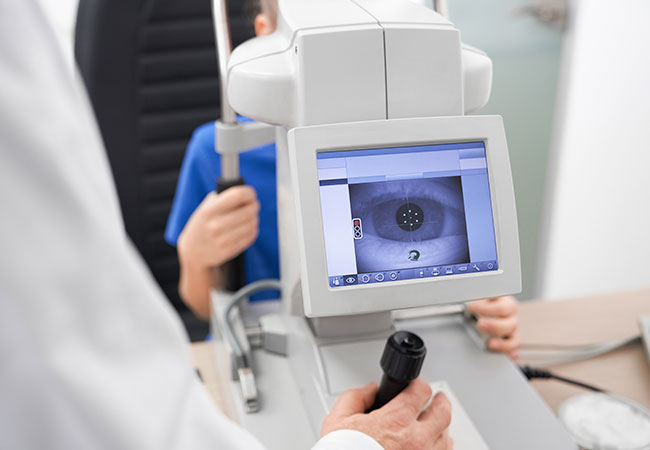Presentation
Macular degeneration can affect patients from the age of 55. There is an increased risk in case of family history and smoking. With the help of our latest generation equipment, we are able to detect the early signs of macular degeneration before the disease manifests itself, and thus act as early as possible.

The macula is the central area of the retina. With age, its function can gradually deteriorate, affecting fine central vision. Age-related macular degeneration (AMD) is the leading cause of central vision loss in people over 50 in Western countries. Women are more affected than men.
The first signs of AMD are difficulty in adapting to sudden changes in light. Reading (near vision) becomes difficult and requires better lighting. Straight lines seem to waver and distort (Amsler grid test). Central vision becomes blurred, a black spot appears.
Type of AMD
There are two types of AMD: dry AMD and wet AMD. Dry AMD is caused by tiny deposits, called drusen, which gradually damage the cells of the macula over the years. This type of macular degeneration is the less progressive of the two and occurs in 90% of cases.
The remaining 10% suffer from wet AMD, also known as neovascular AMD, which develops more rapidly. It occurs when abnormal blood vessels develop on the macula. Blood or other fluids can leak out, damaging the cells and causing scarring.
This form of AMD can appear suddenly and affect vision in just a few days. It is therefore very important to consult an ophthalmologist as soon as the first symptoms appear, such as distorted vision of straight lines or a grey spot in the centre of vision.
AMD does not lead to blindness, since only central vision is impaired, but it does lead to an inability to read and recognise faces (this is social blindness). Low vision re-education allows better use of the peripheral vision that is preserved.
Only regular monitoring by a specialist can diagnose AMD and, if necessary, treat it effectively.


What are the means of screening?
Early detection limits the progression of the disease and helps preserve vision. To make a diagnosis, the ophthalmologist will examine the back of your eye, with or without dilation. Depending on the form (dry or wet) and the stage of the disease, he or she may ask for additional tests.
What is the treatment for AMD?
For dry AMD
In addition to monitoring the disease (checks by an ophthalmologist), nutritional supplements, based on vitamins and minerals with antioxidant properties, can be offered at certain stages. They are intended to slow down the evolution of the disease.
Ocular acupuncture can also help to slow down the progression of the disease.
For wet AMD
Available treatments aim to slow the progression of the disease and maintain visual acuity, by stopping the development of new blood vessels and limiting the formation of macular oedema.
They consist of intraocular injections of a substance that combats the development of abnormal vessels.
These injections are performed at the CNVO.

